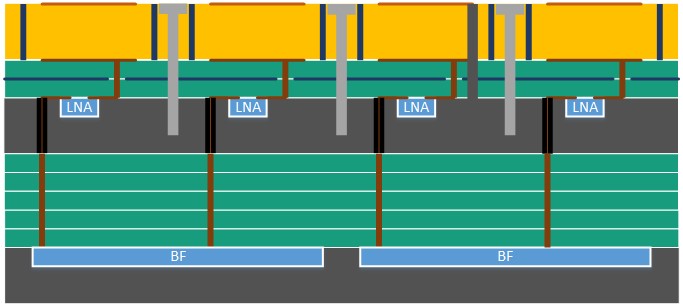
-
StatusOngoing
-
Activity Code5E.022
The objective of the activity is to develop a phased array antenna, suitable for low Earth orbit missions on CubeSat and small satellite platforms. The antenna allows directed communication in Ka-Band, with separate apertures provided for transmitting in the 17.7 to 20.2 GHz and receiving in the 27.5 to 30.0 GHz range. The design is highly modular, with individual tiles of up to 1U. The antenna can either be integrated “as is” on the satellite or used as “blueprint” and adapted as required me meet specific mission needs. For ease of integration, antenna hardware breadboards and a generic software stack for beam‑steering are provided. All hardware is designed using commercially available components and standard manufacturing processes.
Ka-Band frequencies are used terrestrially, e.g. in upcoming 5G networks; this motivated various semiconductor manufacturers to provide “beam former” chips in this frequency range. In turn, this allows to implement highly integrated, compact, and power efficient phased array antennas. However, there are only very few chip solutions that match the specific frequency plan on a satellite, and thus finding the right combination of components and matching them with a wide-angle antenna element is challenging.
Based on data from the NewSpace Index database, there are currently more than 1000 launched CubeSat applications, with more then 50% of these for Earth observation, communications and IoT/M2M use cases. In all these examples, considerably large amounts of data need to be transferred from the satellite down to Earth. Despite some first attempts, no commercial antenna product exists within the ESA Member States that allows to easily enable flexible, higher bandwidth communication capabilities into CubeSats or other smaller satellites.
Providing a modern and highly modular phased array antenna that can either be integrated “as is” on the satellite or used as “blueprint” and adapted as to specific mission needs addresses this market need. This enables CubeSat missions to gather and transmit more data more quickly and without having to invest upfront into the development of a customized antenna solution. Further, as phased array antennas are steerable, the communication window between satellite and ground station extends compared to common body-pointed antennas and thus allows more time for communication.
Product features include:
- Satellite-transmit (Tx) in the popular 17.7 to 20.2 GHz band
- Satellite-receive (Rx) in the popular 27.5 to 30.0 GHz band
- Tx and Rx compatible with standard ground equipment
- Separate Rx and Tx apertures, configurable in sizes from quarter-1U (50 x 50 mm) to full-1U (100 x 100 mm)
- Multi-beam steering capability, over wide field of view
- Equivalent isotropic radiated power (EIRP) and G/T adequate to allow data throughput in the megabit per second range (quarter-1U array, actual throughput depending on satellite distance and modem)
- Radio Frequency interface
- Control software stack and beam‑steering API
The antenna is implemented as a flat panel, consisting of an antenna element layer, cold plate, beam former layer and mounting plate, with all components integrated into the stack-up (see figure).

Each array is composed of a configurable number of antenna elements, with 4 antenna elements controlled by one highly integrated beam former IC. Optional amplifiers are used in between antenna element and beam former for improved G/T and EIRP performance. Distributed combiner/splitter networks connect the beam former to the RF interface connector; no up- or down-conversion is integrated, for maximum compatibility with the satellite’s communication system.
The project is structured into 6 main work packages:
- WP1000: Technical Specification
- WP2000: Select Baseline
- WP3000: Breadboard Design
- WP4000: Implementation
- WP5000: Verification
- WP6000: Outcome Assessment
Work packages are mainly executed in sequence, with key milestones at the end of each WP.
Project kick-off was in April 2024 and the activity is expected to run 30 months, until October 2026. Finalised specification and baseline design are expected in early 2025. This is followed by several prototype hardware builds in 2025 and an extensive testing campaign in 2026.





